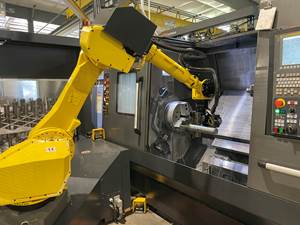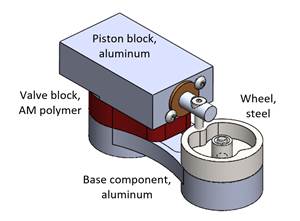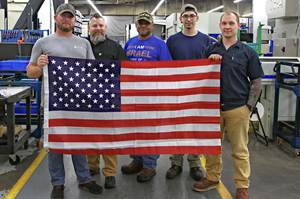FIFO Lane Helps Job Shops Regulate Work Flow
In last month's column, I discussed how supermarkets can help companies maintain flexibility by regulating the work flow of critical processes. Supermarkets do a great job of aligning demand and production capacity, which is key to a lean flow.
Share





In last month's column, I discussed how supermarkets can help companies maintain flexibility by regulating the work flow of critical processes. Supermarkets do a great job of aligning demand and production capacity, which is key to a lean flow. However, some job shops specializing in custom fabricated products may have a hard time implementing supermarkets in their environment. Fear not: There is another technique that can be just as effective in regulating work flow in a job shop. This technique is known as a FIFO lane.
You are probably already familiar with the term FIFO or "First In, First Out." The term is used in accounting as a method of calculating the cost of inventory and in warehousing as a means of rotating stock and managing inventory.
FIFO lanes employ the same first in, first out concept to regulate and manage the job flow in a manufacturing operation. Much like a supermarket, in which items are stocked and replenished when inventory reaches a predetermined level, FIFO lanes are established and sized to hold a limited number of jobs.
In our example (see chart below), the FIFO lane consists of four positions. Painted or taped lines on a floor, markings on a roller conveyor or clearly marked space on a shelf can serve to make the FIFO lane visual. In practice, the first job coming from Process A is moved into the first open position in the FIFO lane. Position 1 indicates an empty lane. The next job coming from Process A would be placed in the next open position. The FIFO lane is loaded with the output of Process A until all four positions are filled. Once this occurs, work flow is regulated because no other job can be placed in the FIFO lane until the job in Position 1 is moved to Process B. When a job is moved to the next process, this opens up a space to accept another job from the supplying process.
The FIFO lane limits the amount of work-in-process inventory that can build up by limiting the physical space that inventory can consume. The smaller the FIFO lane, the tighter the control. As the chart shows, there will never be more than four jobs built up waiting for Process B. At the same time, by physically limiting the size of the positions within the FIFO lane, you are regulating not only the number of jobs, but also the quantity of parts that can be contained. For example, if a large job is scheduled for Process A, and the job requires multiple pallets or skids, then the job will consume multiple positions in the FIFO lane.
The regulating feature of the FIFO lane affects the decision of whether or not to start a job in the supplying process. If all boxes in the FIFO lane are filled with jobs, it makes no sense to start a job in Process A. This might be a good time to assign Process A's operator to some other task, rather than risk starting and finishing a job and having no place to put it.
In the FIFO lane example shown, one process feeds another. However, the concept will work just as well in any of the following situations:
1) one process feeds multiple processes; 2) multiple processes feed one process; or 3) multiple processes feed multiple processes. In each of these situations, the regulating feature of the FIFO lane controls the amount of work-in-process inventory that can be generated.
FIFO lanes can be configured in many ways. A single lane is the simplest, but if there are multiple processes involved, there may be a benefit to having multiple lanes lying in parallel.
The size of the FIFO lane is based on a number of factors, including the capacity of both supplying and secondary processes, the rate of customer demand and any system constraints (such as long change-over time or downtime issues) that have not yet been resolved.
Try using a FIFO lane in your job shop. It is easy to implement and will provide an effective means of managing your work flow.
Related Content
Same Headcount, Double the Sales: Successful Job Shop Automation
Doubling sales requires more than just robots. Pro Products’ staff works in tandem with robots, performing inspection and other value-added activities.
Read MoreSolve Worker Shortages With ACE Workforce Development
The America’s Cutting Edge (ACE) program is addressing the current shortage in trained and available workers by offering no-cost online and in-person training opportunities in CNC machining and metrology.
Read MoreInside Machineosaurus: Unique Job Shop with Dinosaur-Named CNC Machines, Four-Day Workweek & High-Precision Machining
Take a tour of Machineosaurus, a Massachusetts machine shop where every CNC machine is named after a dinosaur!
Read MoreFinding Skilled Labor Through Partnerships and Benefits
To combat the skilled labor shortage, this Top Shops honoree turned to partnerships and unique benefits to attract talented workers.
Read MoreRead Next
Machine Shop MBA
Making Chips and 91ÊÓƵÍøÕ¾ÎÛ are teaming up for a new podcast series called Machine Shop MBA—designed to help manufacturers measure their success against the industry’s best. Through the lens of the Top Shops benchmarking program, the series explores the KPIs that set high-performing shops apart, from machine utilization and first-pass yield to employee engagement and revenue per employee.
Read MoreLast Chance! 2025 Top Shops Benchmarking Survey Still Open Through April 30
Don’t miss out! 91ÊÓƵÍøÕ¾ÎÛ's Top Shops Benchmarking Survey is still open — but not for long. This is your last chance to a receive free, customized benchmarking report that includes actionable feedback across several shopfloor and business metrics.
Read MoreAMRs Are Moving Into Manufacturing: 4 Considerations for Implementation
AMRs can provide a flexible, easy-to-use automation platform so long as manufacturers choose a suitable task and prepare their facilities.
Read More




















